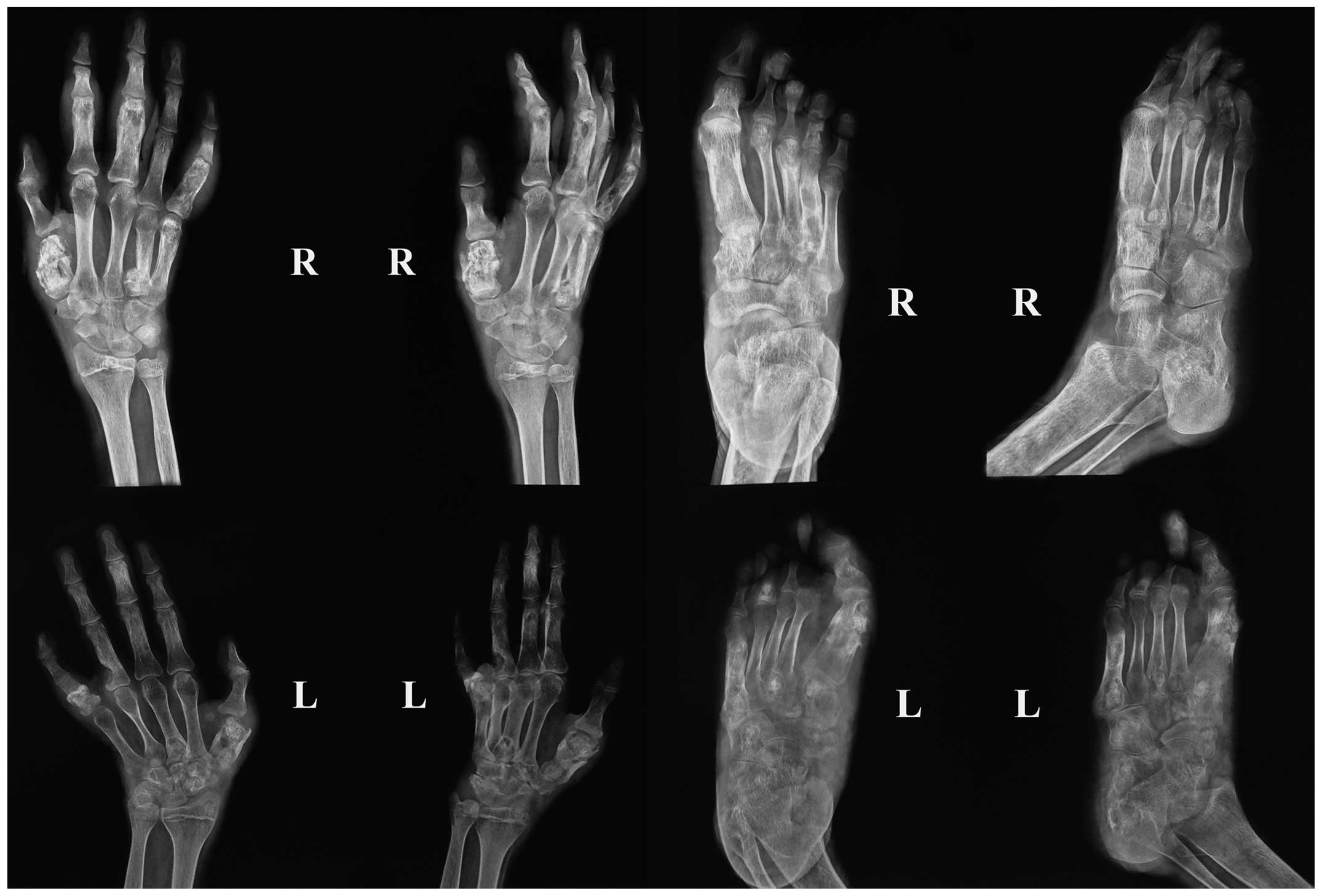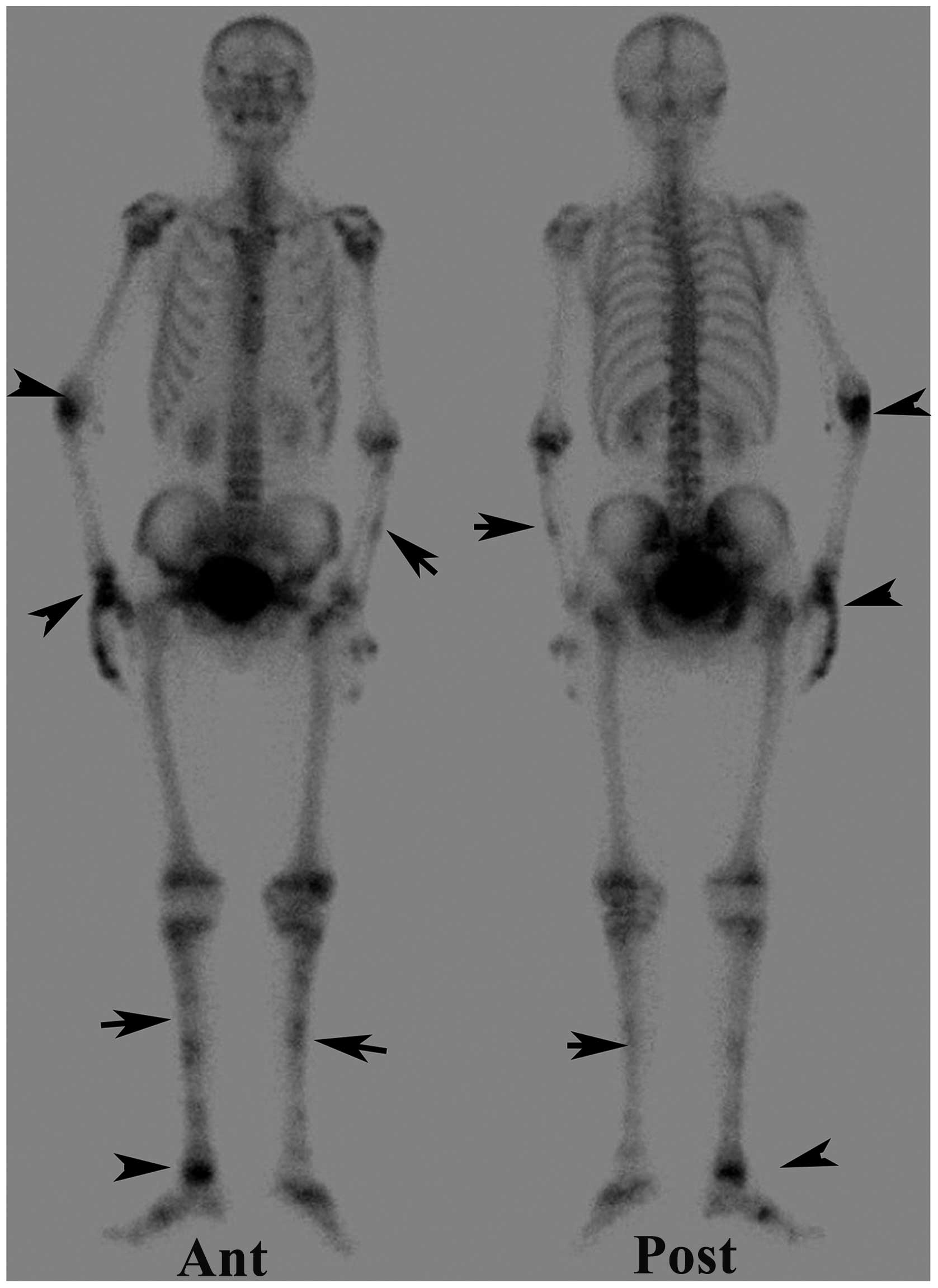Multifocal osteoarticular tuberculosis of the extremities in an immunocompetent young man without pulmonary disease: A case report
- Authors:
- Published online on: April 14, 2015 https://doi.org/10.3892/etm.2015.2425
- Pages: 2299-2302
Abstract
Introduction
Osteoarticular tuberculosis (TB), an uncommon form of extrapulmonary TB, comprises 1–6% of all TB cases and 10–15% of all extrapulmonary TB cases (1–4). The most frequent sites of osteoarticular TB are the spine, hip and knee. Multifocal skeletal TB is rare and accounts for 10% of all osteoarticular TB cases (5).
The diagnosis of multifocal osteoarticular TB is often delayed due to the clinical and radiological resemblance of the disease to numerous malignant and bone diseases (6,7). The consequences of considerable diagnostic delays in multifocal osteoarticular TB can prove critical for patients, since such delays may lead to the spread of the infection from the bone to the adjacent joints and surrounding soft tissue, causing significant functional disabilities (8,9). The present study describes the case report of a patient that presented with multifocal extremity pain and swellings and, following several TB modalities, was diagnosed with multifocal osteoarticular TB. The patient responded well to anti-TB medication.
Case report
A 19-year-old Chinese male presented with multifocal painful swellings of his extremities, particularly around the ankles and the interphalangeal and intermetatarsal joints. The patient had been suffering from the painful swelling for ~3 years and with sinus discharge in certain areas for ~1 year.
Three years ago, the patient felt pain around his left ankle and several interphalangeal joints of the left foot. Subsequently, some of the lesions began to fester. Similar lesions also appeared symmetrically on the left and right hand and right foot. The patient had a history of pulmonary TB that had been diagnosed 6 years prior to these events; however, the district hospital had confirmed that the condition was cured after 6 months of medication (a 2-month treatment with isoniazid, rifampin and pyrazinamide and a 4-month treatment with isoniazid plus rifampin).
Whilst the patient presented with decreased appetite, he had no history of significant weight loss, night sweats or chronic cough, and he had not taken any immunosuppressive or steroid drugs. The most recent computerized tomography (CT) scans of the patient's chest were normal. In addition, no family members of the patient had presented with the same pattern of symptoms. The patient weighed 50 kg and appeared to be malnourished.
Upon physical examination, the proximal interphalangeal joint of the patient's thumb, index, middle and little finger of the right hand, thumb of the left hand and right and left feet were swollen. Ulcers were visible on both of the patient's thumbs and on the left foot. The patient was in pain and had difficulty moving his extremities. Laboratory blood-test results showed normal peripheral blood count values and raised erythrocyte sedimentation rate (75 mm at the end of 1 h). The enzyme-linked immunosorbent assay was negative for human immunodeficiency virus and the radiographs of the thoracolumbar spine, chest and pelvis were normal. The plain radiograph showed soft tissue swelling at the proximal interphalangeal and intermetatarsal joints of the aforementioned digits, as well as narrowing of the joints, and several digits presented with sclerosis and osteopenia (Fig. 1). The whole body 99mTc-methylene diphosphonate (MDP) bone scan revealed multiple abnormal foci in the extremities (Fig. 2). Magnetic resonance imaging (MRI) of both feet revealed pathological signal intensity changes inside the bones, along with marginal enhancement following contrast injection (Fig. 3).
The biopsy of the second left toe lesion showed a granulomatous lesion with necrosis (including Langhans giant cell and epithelioid cell central caseation), which was suggestive of TB; however the acid-fast stain (Ziehl-Neelsen) showed no acid-fast bacilli (AFB). The diagnosis of TB was confirmed by the polymerase chain reaction (PCR). Anti-TB medication was then prescribed, consisting of isoniazid, rifampin, streptomycin and ethambutol. Compared with the previous prescription of the patient, which consisted of three types of medicine, the new regimen comprised four types, including two new drugs that were added in case of drug resistance. After 3 months of treatment, the lesions gradually healed and the pain and swelling subsided. At present, 2 years after the treatment, the patient can stand on his own feet without any symptoms of pain or swelling.
Discussion
To the best of our knowledge, this is the first reported case of multifocal osteoarticular TB affecting all the extremities, predominantly the bones. Although no AFB were detected, positive PCR results for Mycobacterium tuberculosis confirmed the diagnosis. Furthermore, the response of the patient to anti-TB medication revealed strong evidence of TB infection.
Multifocal skeletal TB most often affects the spine, whereas tuberculous arthritis affects the weight-bearing joints and extraspinal tuberculous osteomyelitis affects the skeletal system, excluding the spine (10). The preference of TB for large joints and the spine can be explained by the rich vascular supply of the vertebra and the growth plates of the long bones, in conjunction with the hematogenous spread of TB (11–14). In the present study, TB was observed in the long and short bones and the small joints of the extremities, while the weight-bearing joints, such as the hips and knees, remained healthy. The exact physiological mechanisms of TB remain unclear and direct inoculation cannot completely explain the symmetry of the afflictions. The presence of lesions in atypical positions cannot exclude a diagnosis of TB.
Osteoarticular TB is a major cause of morbidity. Diagnosis of multifocal skeletal TB is frequently delayed due to its rarity and the considerably vague nature of its symptoms. Furthermore, it is difficult to differentiate multifocal skeletal TB from other bone lesions based on clinical or radiological findings alone (15). In the present study, lytic lesions were observed in the plain radiographs of the extremities of the patient, and multiple MDP foci of varied intensity were identified on the bone scans. Several bone diseases, including Ollier's disease and Maffucci syndrome, were initially considered as potential diagnoses. The high-intensity MDP foci surrounding the right wrist, ankle and interphalangeal and intermetatarsal joints may have been partly due to the fact that the left side of the patient's body was affected first, with the right side consequently becoming weight-bearing and functionally compensating. Another possible explanation is that the infection on the right side was more active.
Signal changes on the MRI scans suggested low-grade bacterial infection. MRI can be used to discriminate between abscesses and granulation tissue, delineate soft-tissue mass and identify the amount of bone destruction (16); however, MRI may not be appropriate for whole-body imaging as it is expensive and time-consuming (17). Bone scans, on the other hand, play an important role in the diagnosis and evaluation of TB (17,18), since they can detect unsuspected osseous TB in patients without known systemic diseases, particularly patients suffering from pain but without known malignancies. Bone scans also help to determine the optimal biopsy site and the most suitable area for insightful MRI imaging. Bone TB should be considered among the differential diagnoses when positive bone scans are observed in patients with unknown causes of bone pain, particularly in patients who do not have a known history of malignancy (17,19).
In conclusion, pain and swelling may be presentations of osteoarticular TB infection. Bone and MRI scans are imaging techniques that have proven to be useful in indicating the extent of the disease, particularly in long bone lesions in the early stage of the disease. Bone scans are also useful in establishing those sites that could require further evaluation by CT, MRI or biopsy.
Acknowledgements
This study was supported by the National Natural Science Foundation of China (grant no. 81071184) and the Sector Funds of the Ministry of Health of China (grant no. 201002002).
References
|
Houston A and Macallan DC: Extrapulmonary tuberculosis. Medicine. 42:18–22. 2014. View Article : Google Scholar | |
|
Jutte PC, van Loenhout-Rooyackers JH, Borgdorff MW and van Horn JR: Increase of bone and joint tuberculosis in The Netherlands. J Bone Joint Surg Br. 86:901–904. 2004. View Article : Google Scholar : PubMed/NCBI | |
|
Sandher DS, Al-Jibury M, Paton RW and Ormerod LP: Bone and joint tuberculosis: Cases in Blackburn between 1988 and 2005. J Bone Joint Surg Br. 89:1379–1381. 2007. View Article : Google Scholar : PubMed/NCBI | |
|
Hong L, Wu JG, Ding JG, Wang XY, Zheng MH, Fu RQ, et al: Multifocal skeletal tuberculosis: Experience in diagnosis and treatment. Med Mal Infect. 40:6–11. 2010. View Article : Google Scholar : PubMed/NCBI | |
|
Tuli SM: Tuberculous osteomyelitisTuberculosis of the Skeletal System. 3rd. Jaypee Brothers Medical Publishers Ltd; New Delhi: pp. 174–183. 2004, View Article : Google Scholar | |
|
Go SW, Lee HY, Lim CH, Jee WH, Wang YP, Yoo IeR and Kang JY: Atypical disseminated skeletal tuberculosis mimicking metastasis on PET-CT and MRI. Intern Med. 51:2961–2965. 2012. View Article : Google Scholar : PubMed/NCBI | |
|
Johnstone RH, Ardern DW and Bartle DR: Multifocal skeletal tuberculosis masquerading as metastatic disease. ANZ J Surg. 81:731–733. 2011. View Article : Google Scholar : PubMed/NCBI | |
|
Cheung PY, Ho KW, Lam YL and Shek TW: Unusual presentations of osteoarticular tuberculosis in two paediatric patients. BMJ Case Rep. 2012:bcr20120067142012.PubMed/NCBI | |
|
Dhillon MS and Tuli SM: Osteoarticular tuberculosis of the foot and ankle. Foot Ankle In. 22:679–686. 2001. | |
|
Moore SL and Rafii M: Imaging of musculoskeletal and spinal tuberculosis. Radiol Clin North Am. 39:329–342. 2001. View Article : Google Scholar : PubMed/NCBI | |
|
Gardam M and Lim S: Mycobacterial osteomyelitis and arthritis. Infect Dis Clin North Am. 19:819–830. 2005. View Article : Google Scholar : PubMed/NCBI | |
|
Tuli SM: General principles of osteoarticular tuberculosis. Clin Orthop Relat Res. 39:11–19. 2002. View Article : Google Scholar | |
|
Magnussen A, Dinneen A and Ramesh P: Osteoarticular tuberculosis: Increasing incidence of a difficult clinical diagnosis. Br J Gen Pract. 63:385–386. 2013. View Article : Google Scholar : PubMed/NCBI | |
|
Scanzello CR and Goldring SR: The role of synovitis in osteoarthritis pathogenesis. Bone. 51:249–257. 2012. View Article : Google Scholar : PubMed/NCBI | |
|
Marudanayagam A and Gnanadoss JJ: Multifocal skeletal tuberculosis: A report of three cases. Iowa Orthop J. 26:151–153. 2006.PubMed/NCBI | |
|
Teo HE and Peh WC: Skeletal tuberculosis in children. Pediatr Radiol. 34:853–860. 2004. View Article : Google Scholar : PubMed/NCBI | |
|
Zhang Y, Zhang Y and Ma J: The prospect of incidental detection of unsuspected skeletal tuberculosis by bone scintigraphy should not be overlooked. Clin Nucl Med. 32:435–439. 2007. View Article : Google Scholar : PubMed/NCBI | |
|
Trikha V, Gupta V, Rastogi S and Kumar R: Tuberculosis of calcaneus: Assessing treatment response by Tc-99m MDP scintigraphy. Clin Nucl Med. 29:5062004. View Article : Google Scholar : PubMed/NCBI | |
|
Bhardwaj V, Agrawal M, Suri T, Sural S, Kashyap R and Dhal A: Evaluation of adequacy of short-course chemotherapy for extraspinal osteoarticular tuberculosis using 99mTc ciprofloxacin scan. Int Orthop. 35:1869–1874. 2011. View Article : Google Scholar : PubMed/NCBI |












